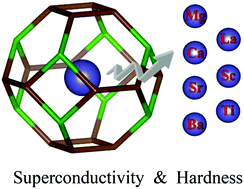Prediction of novel boron–carbon based clathrates†
Abstract
Clathrates are inclusion compounds featured with host framework cages and trapped guest atoms or small molecules. Recently, the first boron–carbon (B–C) clathrate SrB3C3 was successfully synthesized at high pressures near 50 GPa. Upon the substitution of guest atoms, clathrates exhibit tunable applications. For example, LaB3C3 possesses an indirect band gap of near 1.3 eV, whereas the ScB3C3 clathrate is ferroelectric with an above-room-temperature Curie temperature of ∼370 K. To the best of our knowledge, however, there is no report on the investigation of B–C framework clathrates with non-equivalent B : C ratios. By using first-principles swarm-intelligence structure searching computations, we identified two metastable I4/mmm SrB2C4 and LaB4C2 clathrates at 50 GPa, and the framework cage contains six quadrilaterals and eight hexagons with a trapped guest metal located at the center. Their dynamic and enthalpy stabilities may be retained at ambient pressure. Moreover, the possible clathrates are extended by the substitution of the guest atoms with other metals in groups 2, 3, and 4, showing a tunable superconducting critical temperature (Tc) and considerable Vickers hardness (Hv). Intriguingly, a metal-to-semiconductor transition occurs in MB2C4 as the atomic number order of alkaline earth metals increases (M: Mg → Ca → Sr → Ba). The estimated Tc value for I4/mmm SrB4C2 is 19.2 K, while SrB2C4 and BaB2C4 are evaluated as superhard materials with Hv values of 43.6 and 41.2 GPa under ambient conditions, respectively.



 Please wait while we load your content...
Please wait while we load your content...